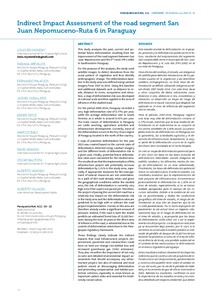Indirect Impact Assessment of the road segment San Juan Nepomuceno-Ruta 6 in Paraguay
This study analyzes the past, current and potential future deforestation resulting from the improvement of the road segment between San Juan Nepomuceno and the 6th route (PR-L1080) in Southeastern Paraguay. For the purpose of the analysis, the study used satellite images to detect deviations from the usual pattern of vegetation and thus identify anthropogenic change. The deforestation baseline in the study area was defined using Landsat imagery from 1987 to 2014. Using this baseline and additional datasets such as distance to roads, distance to rivers, ecosystems and elevation, a map of deforestation risk was developed at national scale and then applied in the area of influence of the studied road.
For the period 2000-2014, Paraguay recorded a very high deforestation rate of 0.77% per year, while the average deforestation rate in South America as a whole is around 0.41% per year. The main causes of deforestation in Paraguay are cattle ranching, agriculture activities and infrastructure development. Currently, most of the deforestation occurs in the Dry Chaco region of Paraguay located in the north of the country.
A map of potential deforestation for the year 2023 was created based on the current rates of deforestation detected using Landsat imagery and the different levels of deforestation risk in a given area. Finally, potential future deforestation rates were calculated for the studied area. The results show that the implementation of this infrastructure project will potentially increase deforestation by 1.41% in the study area, especially, if appropriate measures for the management of natural resources are not undertaken. As a path of dirt road already exists and given the geographical conditions within the studied area, the risk of deforestation is currently very high even if the road is not paved yet. Therefore, the project of paving the current dirt road has a relatively low impact on the deforestation risk in the study area and the deforestation rates are predicted to be high with or without the road project implementation. Forests in this area are therefore already under a significant amount of pressure. Indeed, if the road is built the model predicts an estimated forest loss of 15,603 hectares during the next 10 years in the direct area of influence of the road, a substantial loss in the context of deforestation restrictions in the Paraguayan regulatory framework.
These findings clearly indicate the indirect impacts that road infrastructure projects (improvement, pavement and construction) could have on land use change (via habitat loss and increased greenhouse gas (GHG) emissions). They also reconfirm the importance of not only ex-ante and detailed environmental impact assessments that should accompany any infrastructure project, but also of national and local policies aimed at discouraging deforestation and promoting compensation and habitat protection schemes, especially in areas known as important carbon sinks and essential for biodiversity conservation.

